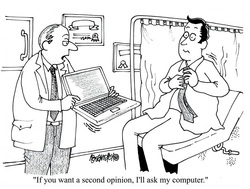 This was also published on the British Geriatric Society Blog site If you watched the news this week you might have thought that the only recommendation in the NICE Atrial Fibrillation Guideline was that doctors should not prescribe aspirin to prevent strokes. In fact most cardiologists and geriatricians stopped using aspirin for this condition several years ago and the NICE recommendation simply reaffirms those issued previously by other professional societies such as the European Society of Cardiology. The real story behind the guidelines was, in my opinion, nothing to do with medication or rate versus rhythm but rather the importance of delivering a personalised package of care for patients with atrial fibrillation (AF). Recognising that AF is a long term health condition there is emphasis on the importance of shared decision making processes particularly around anticoagulation. Alongside the guideline NICE published a Patient Decision Aid to assist with this process. The intention behind this is good but having shown the 36 page decision aid document to several patients today they were overwhelmed by the volume of information they were expected to digest. The aid includes much information that would not be relevant to the individual patient since it tries to cover the risks and benefit of all patients with various stroke and bleeding risks. It uses Cates plots to try and aid the decision making process but each chart has 1000 faces and only looks at the risks/benefits over one year so the faces benefiting from treatment are swamped by hundreds of faces not expecting any benefit. On a practical note NICE assumes that clinicians will have ready access to a colour printer otherwise the red/greens charts look somewhat monotone. The comparison of this decision aid with the highly professional and dynamic way information is presented on the JBS3 risk calculator website is striking and NICE need to up their game to make this and further decision aids much more user friendly. Summarising the information on two sides of A4 is aspirational but possible as has been done with other documents on breast and prostate cancer screening as has been promoted by the work of Gerd Gigerenzer. The guideline emphasises that the patient’s decision regarding anticoagulation will be affected by their own attitude towards risk and NICE say that if patients are provided with the appropriate information about the pros and cons they should be able to decide for themselves about whether to have treatment with anticoagulation or not. This removes the recommendation or opinion of the healthcare provider from the consultation and devolves the decision making to the patient. This represents a change in the doctor patient relationship and the dynamics of the consultation. In my experience, patients want to know the pros and cons of a particular treatment but are also interested in the opinion of the healthcare professional especially if they are well known and trusted. In everyday life we use rules of thumb – so called heuristics and recommendations from friends and family feed into the ability to make complex decisions. Often personal experience and anecdotes are trusted in preference to scientific evidence. To devolve the decision making completely to the patient might be seen as convenient for the healthcare professional. If the patient chooses anticoagulation and then bleeds – it was the patient’s decision to start the treatment, not the doctors. If the patient decides not to take anticoagulation and has a stroke then again it was their decision. In practice clinical medicine is complex and the interaction between a patient and an experienced clinician vital to make a detailed and appropriate assessment. Although stroke and bleeding risk can be calculated using scoring systems these measures are not perfect and derive from large populations which do not necessarily apply to the patient in the consulting room who may have complex multisystem disease and polypharmacy. The risk assessment tools are a starting point of the conversation about treatments. NICE should be commended for placing the patient’s involvement in deciding their management of AF centre stage. This is a clear move in the right direction for patients and should improve both outcomes of this common condition.
0 Comments
 It usually goes like this. Mrs Jones is a lady in her mid-70s with a history of controlled hypertension. An irregular pulse is detected by a practice nurse usually during a routine blood pressure check. Atrial fibrillation is confirmed on an ECG and she is referred to cardiology outpatients. We go through the history, examination and then onto the management. I usually break this down into management of symptoms and reduction of stroke risk. In the asymptomatic patient the former is usually very easy so we rapidly move onto the latter which is usually more challenging. I explain that AF is associated with an increased risk of stroke. 10,000 people a year are admitted to hospital in the UK with a stroke and found to be in AF. Then we arrive at the moment of the consultation where the W word is mentioned. I have tried to introduce this gently using the word anticoagulation, talking about little clots in the heart, preventing them by thinning the blood but finally the W word has to come out: "So Mrs Jones I would recommend that we start you on Warfarin." A moment later the patient looks crestfallen. The reply is usually a combination of 1) I don’t want to go onto warfarin; 2) I have a friend/relative/neighbour who is on it and they have had terrible trouble; 3) I was dreading you would say that; 4) Can’t I just continue with the aspirin after all that thins the blood too doesn’t it? 5) Can I leave it for now and take it if things get worse. I usually ask the patient “What is your biggest worry?” and often the reply is: “I don’t want to have stroke!” We are recommending more and more anticoagulation. The awareness of the increased stroke risk associated with AF is rising and there are comprehensive guidelines recommending anticoagulation which apply to ever increasing numbers of patients. Anticoagulation in AF is now regarded by the pharmaceutical industry as big business. This made me consider the risks and benefits of different types of stroke prevention therapy for AF. Guidelines have made this easy. Calculate the CHADS2 or CHADSVASC score of the patient and if it is more than 1 for CHADS2 or 2 for CHADSVASC then anticoagulation is recommended. You don’t need to know or think about the absolute risk numbers just a simple addition. The guideline tells you when to start anticoagulation and of course if you follow the guidelines you can’t be criticised. On the other hand if the patient has a stroke and you didn't recommend warfarin then that is not good. If the patient has a serious bleed due to the warfarin then you can’t be criticised for following the guidelines, can you? Sometimes it helpful to think about the actual numbers behind these guidelines to see exactly the benefits and risks of the different treatments. It is common to tell the patient that anticoagulation reduces risk of stroke by two thirds - impressive. Consider Mrs Jones, she has an annual estimated stroke risk of 4.3% and an annual bleeding risk of 0.6% according to the risk calculators. Treating her with aspirin reduces the risk of stroke to 3.4% (22% RRR; 0.9% ARR, with a 1 in 106 chance of benefit per year). The risk of major bleeding rises to 1.1% (1 in 222 chance of being harmed). So a miniscule chance of benefit and miniscule chance of harm. Giving warfarin reduces stroke risk to 1.4% (66% RRR; 2.9% ARR, with a 1 in 35 chance of benefit per year) but the risk of major bleeding rises to 3.1% (1 in 40 chance of being harmed). If there are 1000 patients similar to this then by doing nothing 43 will have stroke and 6 of them a major bleed over the next year. Treat them all with warfarin prevents 29 strokes but cause 25 major bleeds. Treated them with aspirin prevents 9 strokes but cause 5 major bleeds. I guess it all depends on whether you fear stroke or bleeding more, major bleeding provided it is not cerebral haemorrhage is not usually associate with long term disability and so may be trying to compare apples with pears and remember the patients biggest fear was of having a stroke. The current recommendation is that anyone with a CHADS2VASC score of 2 or more should be offered anticoagulation. It is clear that warfarin treatment is associated with a benefit. As doctors we tend to emphasise the positives and stress the 66% risk reduction with warfarin compared to the 22% with aspirin. We do not stress the 5-fold increase in the risk of major bleeding associated with warfarin. There has been a huge interest in atrial fibrillation recently. Some of this has been driven by the availability of the new oral anticoagulant drugs and the intense advertising war between the different companies to position their drug as the most effective. This has also been accompanied by an awareness campaign to doctors regarding the stroke risk associated with atrial fibrillation as well as community clinics funded by the pharmaceutical industry intent on finding cases of atrial fibrillation and reviewing the anticoagulation treatment. As physicians we tend to play down the harmful effects of the treatments and emphasise the positives. We want to practice according to the guidelines. If you were the patient with AF and you were told you there was a 1:35 chance of benefit with warfarin and 1:40 chance of harm what would you do? |
Dr Richard BogleThe opinions expressed in this blog are strictly those of the author and should not be construed as the opinion or policy of my employers nor recommendations for your care or anyone else's. Always seek professional guidance instead. Archives
August 2023
Categories
All
|
 RSS Feed
RSS Feed

